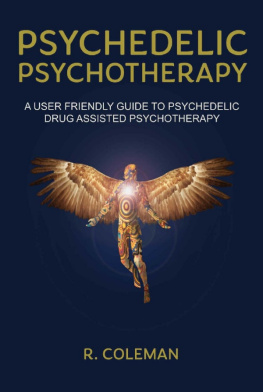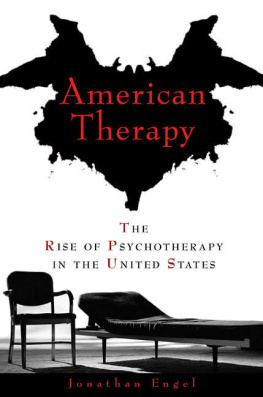Copyright 2014 by the American Psychological Association. All rights reserved. Except as permitted under the United States Copyright Act of 1976, no part of this publication may be reproduced or distributed in any form or by any means, including, but not limited to, the process of scanning and digitization, or stored in a database or retrieval system, without the prior written permission of the publisher.
Electronic edition published 2014.
ISBN: 978-1-4338-1620-8 (electronic edition).
Published by
American Psychological Association
750 First Street, NE
Washington, DC 20002
www.apa.org
To order
APA Order Department
P.O. Box 92984
Washington, DC 20090-2984
Tel: (800) 374-2721; Direct: (202) 336-5510
Fax: (202) 336-5502; TDD/TTY: (202) 336-6123
Online: www.apa.org/pubs/books
E-mail:
In the U.K., Europe, Africa, and the Middle East, copies may be ordered from
American Psychological Association
3 Henrietta Street
Covent Garden, London
WC2E 8LU England
Cover Designer: Mercury Publishing Services, Inc., Rockville, MD
The opinions and statements published are the responsibility of the authors, and such opinions and statements do not necessarily represent the policies of the American Psychological Association.
Library of Congress Cataloging-in-Publication Data
Psychotherapy theories and techniques : a reader / edited by Gary R. VandenBos, Edward Meidenbauer, and Julia Frank-McNeil. First edition.
pages cm
Includes bibliographical references.
ISBN 978-1-4338-1619-2 ISBN 1-4338-1619-9 1.Psychotherapy. 2.PsychotherapyPhilosophy. 3.PsychotherapyMethodology. I. VandenBos, Gary R., editor of compilation. II. Meidenbauer, Edward, editor of compilation. III. Frank-McNeil, Julia, editor of compilation.
RC480.5.P785 2014
616.89'14dc23
2013020747
British Library Cataloguing-in-Publication Data
A CIP record is available from the British Library.
First Edition
http://dx.doi.org/10.1037/14295-000
CONTENTS
Steven C. Hayes and Jason Lillis
Steven C. Hayes and Jason Lillis
Martin M. Antony and Lizabeth Roemer
Martin M. Antony and Lizabeth Roemer
Hanna Levenson
Hanna Levenson
Keith S. Dobson
Keith S. Dobson
Michelle G. Craske
Michelle G. Craske
Vittorio F. Guidano
Greg J. Neimeyer
Leslie S. Greenberg
Leslie S. Greenberg
Kirk J. Schneider and Orah T. Krug
Kirk J. Schneider and Orah T. Krug
William J. Doherty and Susan H. McDaniel
William J. Doherty and Susan H. McDaniel
Laura S. Brown
Laura S. Brown
Derek Truscott
Uwe Strmpfel and Rhonda Goldman
Lillian Comas-Daz
Lillian Comas-Daz
Stephen Madigan
Stephen Madigan
David J. Cain
David J. Cain
Jeremy D. Safran
Jeremy D. Safran
Albert Ellis and Debbie Joffe Ellis
Albert Ellis and Debbie Joffe Ellis
Robert E. Wubbolding
Robert E. Wubbolding
Judith V. Jordan
Judith V. Jordan
Lawrence P. Riso and Carolina McBride
Lawrence P. Riso, Rachel E. Maddux and Noelle Turini Santorelli
PREFACE
Whether you are a student in a clinical training program or a seasoned practitioner, you may find it difficult to grasp the full range of psychotherapy theories or to become even partially acquainted with the plethora of associated techniques. My hope is that this book will be of assistance. This is a readera compendium of excerpts of previously published work. We chose to create this reader to provide access to some of the best writing the American Psychological Association (APA) has published on clinical theories and techniques in psychotherapy. The book surveys the great variety of orientations practiced today and provides not a complete explanation of each but rather a glimpse of these orientations at their richestneither distilled into pat definitions nor tidily packaged into bullet points and takeaway phrases. Instead, short encounters with the best writing on each approach, afford the reader a look at the way psychotherapy is practiced today.
For every psychotherapeutic approach we have included an excerpt on theory and an excerpt on the therapeutic process. At the end of the excerpt on the therapy process we have included a list of techniques associated with that approach to therapy. Some of these techniques appear in the excerpts; others do not appear there. All are well-known interventions used by practitioners of the orientation in question.
In addition, we have provided guidance on where to find video examples of the techniques in our database of psychotherapy demonstrations, PsycTHERAPY. Although PsycTHERAPY is a product quite different from the individual videos in the APA Psychotherapy Video Series, it was created for the same purpose: training and educating psychotherapists. Just as the APA Psychotherapy Video Series has its companion booksfrom The Anatomy of Psychotherapy: Viewers Guide to the APA Psychotherapy Videotape Series to the more recent Exploring Three Approaches to Psychotherapy this book may be considered as a companion to PsycTHERAPY.
Readers will find that viewing the video clips listed in the chapter appendixes will augment the glimpse into psychotherapy practice provided by the text excerpts. APA created its various psychotherapy video products because there is no better way to demonstrate the timing, the look, the feel of a technique than to capture it in video. In one way, the excerpts and the video clips may be seen as serving the same purpose. That is, just as we have captured a segment of our best writing on theory and technique in this book, we have also captured segments of our videos that best demonstrate some of the techniques for each of these theories. The technique lists are a road map to finding these video clips.
Psychotherapy Theories and Techniques may be enjoyed on its own, without the use of the videos, as an overview and introduction to the many psychotherapies that exist today. The technique lists will be useful in that they neatly identify the key techniques associated with each approach. Our recommendation is to use the book in combination with PsycTHERAPY by first reading the excerpts for each approach and then viewing all of the associated video clips. This will give a vivid introduction to each orientationnot a full one, not one meant to provide the background necessary to take up practice of the approachbut certainly enough of an introduction to get a good sense of what each of these orientations is about.
Observant readers will notice that many of the excerpts in this volume come from chapters in the APA Theories of Psychotherapy book series. If the writing intrigues you, I suggest going to the original books themselves to read more, as they provide a succinct introduction to the history, theory, and therapeutic process of the major approaches. Whatever further reading this volume inspires, my hope is that Psychotherapy Theories and Techniques: A Reader will provide a glimpse of the breadth, depth, and richness of psychotherapy as it is practiced today.
Gary R. VandenBos, PhD
APA Publisher
HOW TO USE THIS BOOK WITH PSYC THERAPY, APAS DATABASE OF PSYCHOTHERAPY DEMONSTRATION VIDEOS
Psychotherapy Theories and Techniques: A Reader contains 38 chapters, each made up of an excerpt from previously published work from the American Psychological Association (APA). The chapters are paired up: The first chapter in each pair is an excerpt on a psychotherapy theory, and the second chapter is on psychotherapy technique. After the second chapter in each pair, there is an appendix of techniques associated with the approach discussed in that pair of chapters.










